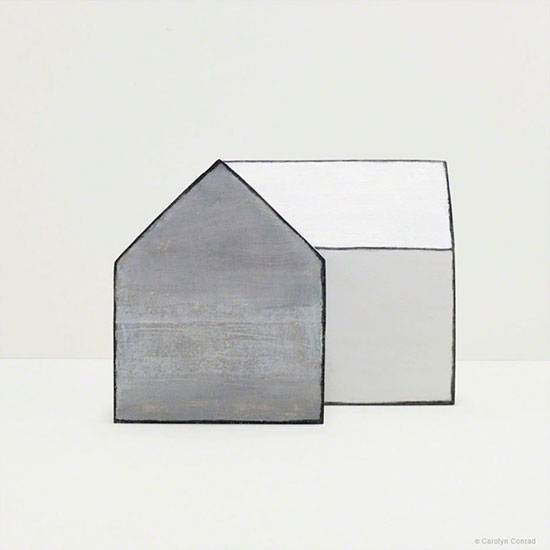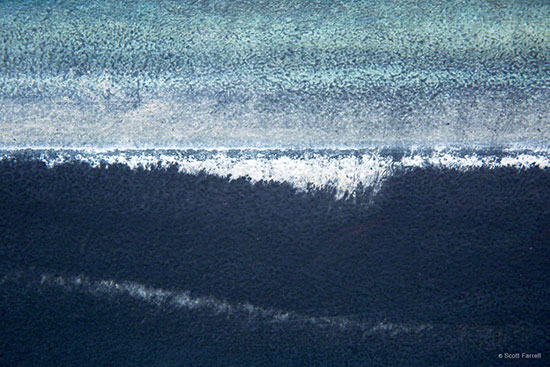The smart and sassy “Perceptive Dimension” show featuring photographs by Carolyn Conrad and Scott Farrell at Alex Ferrone Gallery in Cutchogue, toying mercilessly with the viewer’s slippery grasp of image recognition, opens with a quiet proposition and builds to an argument of irrefutable beauty.
The first work in the show, Locked In by Carolyn Conrad of Sag Harbor, presents a sedate little saltbox of a house, its weathered siding brushed with greys, centered on a white ground that appears as fine and inviting as talc. The monolithic unity of this image leads gradually on to groupings of similar structures—precious photos mostly in the same silvery scale of greys capturing small models in clay and wood hand made by Conrad. Taken together, the works gradually give up the secret of their combinatory compositions.
.

"Locked In" by Carolyn Conrad, 2016. Archival pigment print, 21 x 21 inches, edition 1/10. Courtesy of Alex Ferrone Gallery.
.
The marvelous premise of “Perceptive Dimension” is the soft power of art to activate the mind’s understanding of how perception works. Challenged with an illusion, the eye and mind dance through works by both Conrad and Scott Farrell, who lives in Huntington Station. The fuzzy play of unreality is a welcome departure from the sharp-edged documentary forthrightness of so much photography, conferring a painterly lyricism on the show that I found seductive.
Conrad grew up in Acton, Massachusetts, according to press materials from the gallery, and a distinctively New England atmosphere pervades the two rooms devoted to the adroitly interspersed works by the two artists. In Conrad’s Group, the four structures— the large yet distant figure is a superb drawing added by Conrad and then photographed as a backdrop—take on some of the small town feeling of an Emily Dickinson or Robert Frost poem. There is also a theatrical side to this series, which Conrad has titled “Site Specific,” that belongs more to Thornton Wilder.
.

"Group" by Carolyn Conrad, 2016. Archival pigment print, 19 x 25 inches, edition 2/10. Courtesy of Alex Ferrone Gallery.
.
This is especially true of the spotlit, advancing blank soliloquy suggested by Conrad’s Step Forward, one of the strongest works, in psychological terms, in the exhibition. The sculptural presence of the works reminds me as well of the plangent ceramic suites of Edmund de Waal and also the way Rachel Whiteread plays the façade against the implied interior in her deeply moving cast pieces, larger scale riffs on this architectural theme.
.

"Step Foward" by Carolyn Conrad, 2017. Archival pigment print, 21 x 25 inches, edition 1/10. Courtesy of Alex Ferrone Gallery.
.
It might be tempting to confine these photographs to the level of still lifes in a subdued palette of greys. Comparisons with the ghostly pastels of the maestro Giorgio Morandi seem inevitable, particularly given the palette of Conrad’s current work and the sfumato of the edges. Even the stately pavanne through which the little houses change positions on the stage is similar to the grouping and re-grouping through which Morandi rings the changes in his basic still-life setups. And yet there are elements of complexity to experiencing her art that are probably in keeping with Conrad’s intellectual background: she had her early art training at the Boston Museum of Fine Arts, developed her aesthetic at UMass, and then earned an MA from NYU.
The rule of thumb with theme and variations, in music, is to start small and simple and build steadily to a greater complexity in which the theme is disguised. The great cathedral of Bach’s Goldberg Variations, for example, rises from a simple air. The clear logic of this compositional principle is a perfect guide to appreciating Conrad’s brilliantly understated series.
Having visited her skylit studio on the second floor of her old house in Sag Harbor, I had the benefit of understanding the process behind these elusive and brilliant works, but viewers can fill in the blanks just by looking with care and following the sequence. Conrad meticulously assembles still life groups of small-scale, hand-built “houses” (as they are referenced in her artist statement) made of wood and clay. She photographs them using only sunlight, which was flooding the studio in the case of some of these, as their radiantly bleached roofs indicate. Conrad is careful to disguise the light source to blur the signals that shadows send about the progress of a rising or setting sun.
Her mantra is “no narrative” even if the viewer inevitably fills in the plot based on personal preferences. Her eloquent artist’s statement offers other clues to understanding her intention when looking at the work: “The disciplines of painting, drawing, sculpture, and photography help me create an exterior landscape that offers balance, tranquility and a respite from an internal world, houses that we know may not be empty or simple inside.”
A different sort of perceptual game is afoot with Farrell. The livid red and Avery-quality yellow of Red Sea Coastline or the pounding surf in The Crest appear at first to convey viewers smoothly to landscape photography. The roiling waves and swirling clouds of Farrell’s seascapes are so convincing that it comes as a shock when the viewer realizes the trick that has been played on perception. It is hard not to admire the audacity of the deceptive stratagem.
.

"Red Sea Coastline" by Scott Farrell, 2016. Archival pigment print, 13 x 19 inches, edition 1/10. Courtesy of Alex Ferrone Gallery.
.

"The Crest" by Scott Farrell, 2016. Archival pigment print, edition 1/10. Courtesy of Alex Ferrone Gallery.
.
Picking a one- or two-foot section of the hull of a boat in drydock (a pun is deployed for the series title, “Dry Documentaries”), Farrell closes in on a passage that suddenly blows up into a beach-long epic of Turneresque grandeur. In his artist statement, Farrell calls these works “temporary landscapes.”
.

"Squall" by Scott Farrell, 2016. Archival pigment print, 13 x 19 inches, edition 1/10. Courtesy of Alex Ferrone Gallery.
.
The statement offers these details about his process: “Seemingly endless and remote with a scope that appears vast and expansive, these multi-dimensional landscapes actually exist within small planar areas. Closing in on these often-organic abstractions created a realistic perspective with distant viewpoints, while in reality, these scenes may only measure less than one or two feet in area.” These photographs are accurate and mendacious at the same time.
Through the pairing of photography by Conrad and Farrell, “Perceptive Dimension” will reward art lovers from either fork and even farther away to stop in and check out the show.
__________________________
BASIC FACTS: “Perceptive Dimension,” photographs by Carolyn Conrad and Scott Farrell, is on view September 9 to October 8, 2017 at Alex Ferrone Gallery, 25425 Main Road, Cutchogue, NY 11935. www.alexferronegallery.com
__________________________
Copyright 2017 Hamptons Art Hub LLC. All rights reserved.
